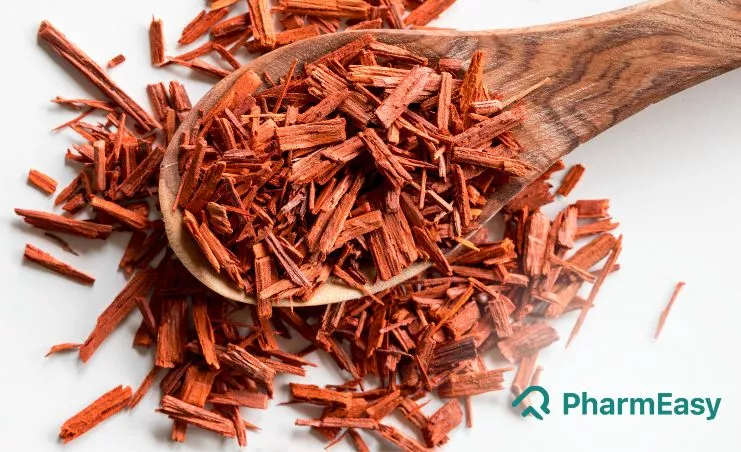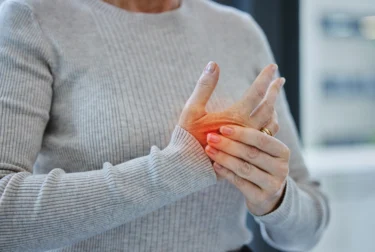Red Sandalwood: Uses, Benefits, Side Effects and More By Dr. Smita Barode
By Dr Smita Barode +2 more

Get,

to manage your symptom
Get your,


4 Cr+ families
benefitted

OTP sent to 9988776655



You’ve successfully subscribed to receive
doctor-approved tips on
Whatsapp

Get ready to feel your best.

Hi There,
Download the PharmEasy App now!!


Register to Avail the Offer
Send OTPBy continuing, you agree with our Privacy Policy and Terms and Conditions

Hi There,
Sign up on PharmEasy now!!
Trusted by 4 crore+ families

OTP sent to 9988776655



You have unlocked 25% off on medicines




Code: NU25
By Dr Smita Barode +2 more
Table of Contents
Red Sandalwood, commonly called Raktachandan or Red Sanders. It is scientifically known as Pterocarpus santalinus and belongs to the family Fabaceae. Red Sandalwood is a highly-valued wood having a commercial value ranging from eight lakh to twelve lakhs per ton as per Government rates. It is a small-sized tree with a hard, dark purple wood part at the centre called the heartwood, which has a bitter flavour. The Raktachandan tree is native to India and is well distributed in dry and hilly regions of Andhra Pradesh, Karnataka, Tamil Nadu, Odisha, West Bengal and Maharashtra. Red Sandalwood is considered sacred in Hindu culture and is extensively used for many rituals. Hence, red Sandalwood has different common names, such as Lal Chandan, Yerra Chandanamu, Tambada Chandana, Agaru Gandhami, Rakt Chandan, Patrangam, etc1,2. Read along to learn more about the health benefits of red Sandalwood, its bioactive components, properties, uses and more.
Red Chandan may include the following minerals:

The major bioactive compound of Red Sandalwood may be santalin which imparts a distinct red colour. Red Chandan may also contain biologically active compounds like phenols, alkaloids, saponins, flavonoids, glycosides, triterpenoids, sterols, tannins, isoflavones, glucosides, savinin and calocedrin1,2.
Red Sandalwood may have the following properties:
Red Sandalwood may benefit human health2. The following may be the potential uses of Red Sandalwood:

A study2 by Sandra et al. in 1996 found that red Sandalwood for the face may reduce skin diseases. Red sandalwood powder may have antibacterial effects against certain bacteria causing acne and pimples reducing the chances of getting acne or pimple. A freshly made Lal Chandan paste may contain the bioactive compound santalin A and santalin B. When applied on the face, it may help relieve the itchy red rash and mild swelling of the skin. Red Sandalwood may also reduce prickly heat due to its anti-microbial activity. However, further clinical studies are required to develop a true scope of red Sandalwood for skin diseases. If you have skin abnormalities, consult a dermatologist. Do not self-medicate.
I highly recommend the use of red sandalwood in your daily skincare routine. Red sandalwood might be your ally in your journey to flawless skin. Because of its cooling qualities, red sandalwood may aid in the eradication of tan and dryness. Apply red sandalwood paste on the skin and witness astonishing transformations gradually6.
Dr. Rajeev Singh, BAMS

Red Sandalwood may relieve your issues related to your stomach. According to Kondeti et al., 20101, the decoction infusion made from Lal Chandan may be used as a tonic to relieve chronic dysentery. In addition, the red sandalwood bark powder may have cooling properties. It may be used to prepare soft porridge and to stop diarrhoea. Furthermore, studies are needed in humans to suggest the true effects of red Sandalwood for managing diarrhoea in humans. Therefore, consult your doctor in case of stomach-related problems. Do not self-medicate.

An animal study3 by Ratnamraju et al. (2018 found that red Sandalwood may have anti-inflammatory and analgesic activity. It may help reduce inflammation as well as the pain associated with it. When the animals were given the decoction of Lal Chandan powder, it showed positive results against acute inflammation compared with the standard drug ibuprofen. Hence, red Sandalwood may be effective against inflammation. However, this study is insufficient as it is an animal study. Therefore, more human studies are needed to claim the uses of red Sandalwood. Consult a qualified physician and do not self-medicate.

Red Sandalwood may have a blood sugar-lowering ability. Lal Chandan may be used as a traditional, Folklore medicine to manage diabetes. As per Nagaraju et al. in 1991, drinking water in cups made from Red Sandalwood may be beneficial against diabetes. Another study by Apparao et al. in 2005 found that Red Sandalwood might benefit blood glucose levels by reducing the high levels of fats or lipids due to diabetes1,2. Thus, Lal Chandan may be used for managing diabetes in humans. However, the latest interventions on humans are needed to suggest the benefits of red Sandalwood for diabetes. If you have a diabetes problem consult a doctor and do not self-medicate.

Though studies show the potential uses of red Sandalwood in various conditions, these are insufficient and there is a necessity for further studies to develop the scope of the benefits of red Sandalwood on human health.
I recently read an article that suggests using sunscreen containing extracts of red sandalwood may give better sun protection. The red sandalwood has natural colouring properties along with better UV absorption nature5.
Dr. Siddharth Gupta, B.A.M.S M.D (Ayu)
Red Sandalwood may be classified as a spice extract due to its santalin compound, which gives it a red colour. You may use Red Chandan:
You should consult a qualified doctor before using red Sandalwood in large quantities. Do not discontinue or replace an ongoing modern medical treatment with an ayurvedic/herbal red sandalwood preparation without consulting an Ayurvedic doctor. They will guide you with its form and dosage per your health condition.
Red Sandalwood in minimum amounts might be safe. However, a case report4 by Sandra et al., 1996 found that red Sandalwood may develop allergic contact dermatitis (inflammation). In addition, the side effects of red sandalwood powder on face may cause itchy erythema (skin redness) and mild oedema(swelling). If any side effects are seen after using red Sandalwood, immediately consult your doctors and get proper treatment.
Also Read: Akarkara (Pellitory): Uses, Benefits, Side Effects & More!
Using Lal Chandan in larger amounts is not recommended. The following precautions are necessary:
Also Read: Chironji (Charoli): Uses, Benefits, Precautions, Side Effects & More!
More studies are required to establish the interactions between red Sandalwood and drugs. Therefore, one must take medical consultations with an Ayurvedic doctor. They will guide you to use red Sandalwood as a herb.
Also Read: Kutajarishta: Uses, Benefits, Side Effects, and More!
The common names of Red Sandalwood are Raktachandan, Red Sanders, Lalchandan, Patrangam, Ratha sandanam, Tambada Chandana, Agaru gandhami and Yerra chandanamu1.
The side effects of red Sandalwood may be itchy erythema (redness) or oedema (swelling) in affected areas4. If any side effects appear, consult a doctor and get appropriate treatment.
The properties of Raktachandan powder may include anti-inflammatory and analgesic properties3.
Red Sandalwood benefits may help reduce high blood sugar levels. It may reduce the high lipid levels in the body, which might affect glucose levels. If you drink water in cups made from Red Sandalwood, it might be effective against diabetes1.2. However, diabetes is a very serious condition it requires proper diagnosis and treatment. Do not self-medicate.
The main component of Red Sandalwood is called santalin, which imparts a distinct dark red colour1.
1. Azamthulla M, Rajkapoor B. A Review on Pterocarpus Santalinus Linn. World J Pharm Res. 2015;4(2):282–92. Available from: https://www.researchgate.net/profile/Mohammad-Azamthulla-2/publication/319930091_A_REVIEW_ON_PTEROCARPUS_SANTALINUS_LINN/links/59c1f8e3a6fdcc69b92bd26f/A-REVIEW-ON-PTEROCARPUS-SANTALINUS-LINN.pdf
2. Soundararajan V. A Review on Red Sanders (Pterocarpus Santalinus Linn.) -Phyto-Chemistry and Pharmacological Importance. World J of Pharm And Pharma Sci. 2016. p. 667–89. Available from: https://www.researchgate.net/publication/344360474_A_REVIEW_ON_RED_SANDERS_PTEROCARPUS_SANTALINUS_LINN_-PHYTO-CHEMISTRY_AND_PHARMACOLOGICAL_IMPORTANCE
3. Ratnamraju V, Dhande P, Gupta A, Vaz N. Anti-Inflammatory and Analgesic Activity of Oral Decoction of Pterocarpus Santalinus Bark Wood Powder in Acute Inflammation Model. Interna J of Pharma Sci and Res. 2018;9(10):4368–72. Available from: https://ijpsr.com/bft-article/anti-inflammatory-and-analgesic-activity-of-oral-decoction-of-pterocarpus-santalinus-bark-wood-powder-in-acute-inflammation-model/
4. Sandra A, Shenoi S, Srinivas C. Allergic contact dermatitis from red sandalwood (Pterocarpus santalinus). Contact Dermatitis [Internet]. 1996 [cited 2022 Dec 6];34(1). Available from: https://pubmed.ncbi.nlm.nih.gov/8789238/
5. Nanda S, Madan K. Augmentation of aesthetic and antisolar attributes of a sunscreen cream by methanolic extract of Raktchandan (Pterocarpus santalinus). Indian Drugs. 2022 Jun;59(6):67-70. Available from: https://tinyurl.com/4jsk4d9k
6. Banerjee, D., Kumar, M., & Mukopadayay, S. (2022). Formulation and evaluation of herbalbody lotion: A review. International Journal of Health Sciences, 6(S2), 13342²13349. Available from: https://media.neliti.com/media/publications/431153-formulation-and-evaluation-of-herbal-bod-8073cacb.pdf
Disclaimer: The information provided here is for educational/awareness purposes only and is not intended to be a substitute for medical treatment by a healthcare professional and should not be relied upon to diagnose or treat any medical condition. The reader should consult a registered medical practitioner to determine the appropriateness of the information and before consuming any medication. PharmEasy does not provide any guarantee or warranty (express or implied) regarding the accuracy, adequacy, completeness, legality, reliability or usefulness of the information; and disclaims any liability arising thereof.
Links and product recommendations in the information provided here are advertisements of third-party products available on the website. PharmEasy does not make any representation on the accuracy or suitability of such products/services. Advertisements do not influence the editorial decisions or content. The information in this blog is subject to change without notice. The authors and administrators reserve the right to modify, add, or remove content without notification. It is your responsibility to review this disclaimer regularly for any changes.
Comments

Leave your comment...
You may also like
Comments